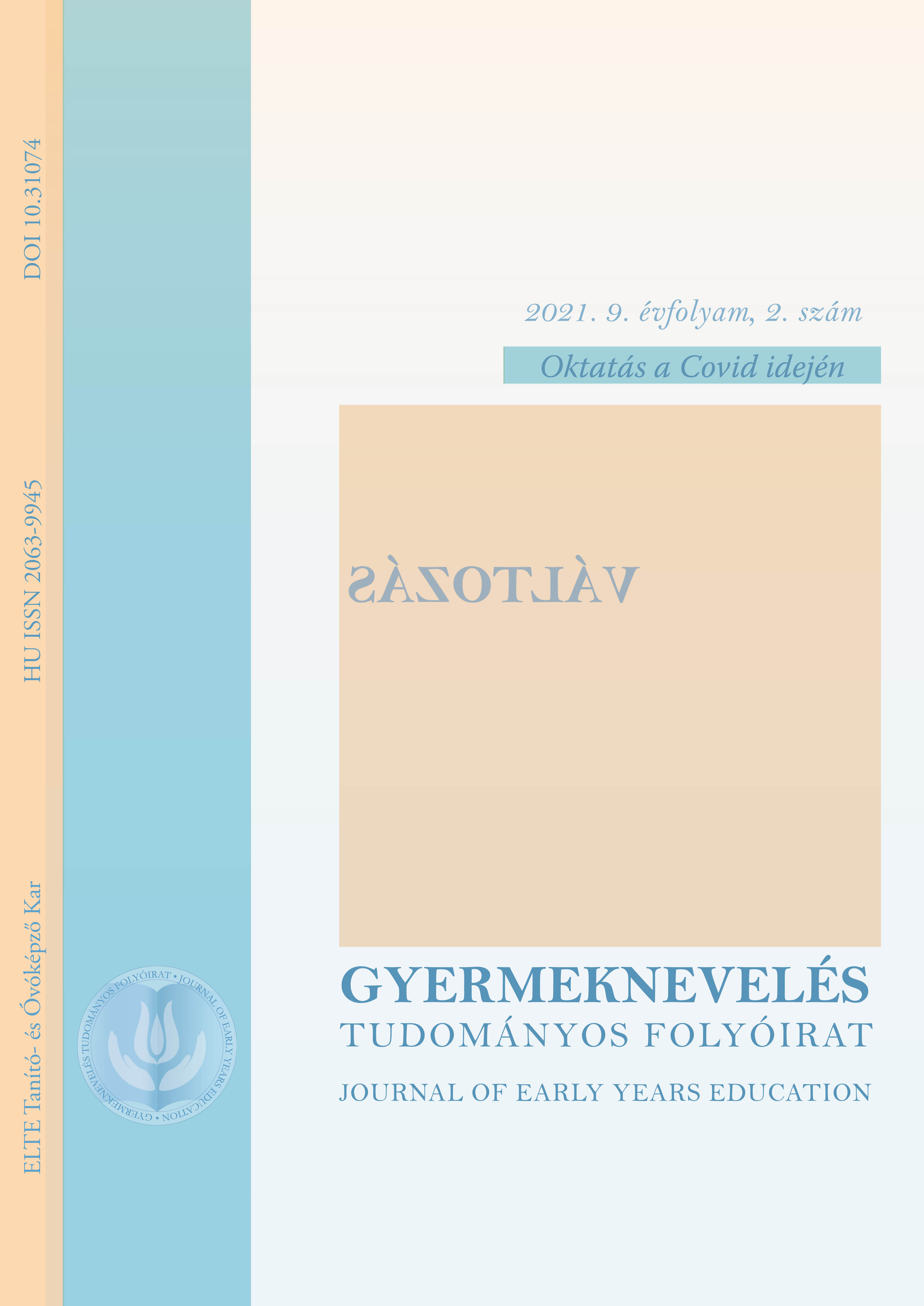‘Television was the only way left to entertain them’ – Changes in the use of ICT and media devices in families of young children during the Covid-19 pandem
DOI:
https://doi.org/10.31074/gyntf.2021.2.187.204Keywords:
Covid-19 epidemic, early childhood, excessive use of ICT/digital media devices, parental controlAbstract
The coronavirus-19 epidemic that began in 2020 resulted in the complete shutting down of institutions serving children in Hungary in the spring of 2020. Parents worldwide had to take care of their children at home and this very often upended family life. Caring for young children at home and reconciling work was a challenge for families which often led to an increase in children’s use of digital devices. In our study, we examined parents raising children under the age of six (N = 391) for general and pandemic “emergency” views and practices related to their young children’s use of media, using an online questionnaire and convenience sampling. Our results show that the majority of young children in the families surveyed were ICT device users even before 2020, and during the pandemic an increase in screen time in 46% of the children studied was recorded. Regarding the general regulation of digital device use, the research revealed four factors, of which the “permissive, non-regulatory” and “controlling, regulating” factors showed a correlation with epidemic-related changes. The general permissive attitude (which is more common among older and less educated parents and older children) was also associated with an increase in ICT device use among children during the epidemic, while general parental control, even during the crisis, did not allow children to use screens excessively. Our results call for awareness-raising among parents about the excessive use of media by young children.
Downloads
References
Anderson, C.A., Bushman, B. J. (2001). Effects of violent video games on aggressive behavior, aggressive cognition, aggressive affect, physiological arousal, and prosocial behavior: a meta-analytic review of the scientific literature. Psychological Science, 12(5), 353–359. https://doi.org/10.1111/1467-9280.00366
B. Németh, M., Hódi, Á., Juhász, F., Sárik, A., & Tóth, E. (2021). Szülők véleménye az óvodáskorú gyermekek IKT-eszköz használatának negatív és pozitív hatásairól. Gyermeknevelés Tudományos Folyóirat, 9(1), 8-38. https://doi.org/10.31074/gyntf.2021.1.8.38
Bérubé, A., Clément, M. È., Lafantaisie, V., LeBlanc, A., Baron, M., Picher, G., Turgeon, J., Ruiz-Casares, M. & Lacharité, C. (2020). How societal responses to COVID-19 could contribute to child neglect. Child Abuse & Neglect, 104761. https://doi.org/10.1016/j.chiabu.2020.104761
Greaves, S., Imms, C., Krumlinde-Sundholm, L., Dodd, K. & Eliasson, A. C. (2012). Bimanual behaviours in children aged 8-18 months: a literature review to select toys that elicit the use of two hands. Research in Developmental Disabilities, 33(1), 240–250. https://doi.org/10.1016/j.ridd.2011.09.012
Hastings, E. C., Karas, T. L., Winsler, A., Way, E., Madigan, A. & Tyler, S. (2009). Young children’s video/computer game use: relations with school performance and behavior. Issues in Mental Health Nursing, 30(10), 638–649. https://doi.org/10.1080/01612840903050414
Healey, A. & Mendelsohn, A., AAP COUNCIL ON EARLY CHILDHOOD (2019). Selecting Appropriate Toys for Young Children in the Digital Era. Pediatrics, 143(1):e20183348. https://doi.org/10.1542/peds.2018-3348
Hsieh, H. C. (2008). Effects of ordinary and adaptive toys on pre-school children with developmental disabilities. Research in Developmental Disabilities, 29(5), 459-466. https://doi.org/10.1016/j.ridd.2007.08.004
Janek, N. (2019). „Google-bácsi mindent tud” – eredmények és tapasztalatok az óvodások digitális eszköz- és internethasználatának vizsgálatáról. Gyermeknevelés Tudományos Folyóirat, 7(2–3), 95-110. https://doi.org/10.31074/20192395110
Kabali, H. K., Irigoyen, M. M, Nunez-Davis, R., et al. (2015). Exposure and use of mobile media devices by young children. Pediatrics, 136(6), 1044–1050.
Kardaras, N. (2017). A képernyő rabjai. Jaffa Kiadó.
Király, O., Potenza, M. N., Stein, D. J., King, D. L., Hodgins, D. C., Saunders, J. B., Griffiths, M. D, Gjoneska, B., Billieux, J., Brand, M., Abbott, M. W., Chamberlain, S. R., Corazza, O., Burkauskas, J., Sales, C. M. D., Montag, Ch., Lochner, Ch. Grünblatt, E. & Demetrovics, Zs. (2020). Preventing problematic internet use during the COVID-19 pandemic: Consensus guidance. Comprehensive Psychiatry, 100, 152180. https://doi.org/10.1016/j.comppsych.2020.152180
KSH (2011). A 2011-es népszámlálási adatok adattáblái. A családtípusok jellemzői. http://www.ksh.hu/nepszamlalas/tablak_csaladtipusok_jellemzoi (2021. 06. 13.)
Konok, V., Peres, K., Ferdinandy, B., Jurányi, Z., Bunford, N., Ujfalussy, D. J., Réti, Z., Kampis, G., & Miklósi, Á. (2020). Hogyan hat a mobileszköz-használat az óvodások figyelmére és társas-kognitív készségeire? Gyermeknevelés Tudományos Folyóirat, 8(2), 13-31. https://doi.org/10.31074/gyntf.2020.2.13.31
Koscsóné Kolkopf, J., & Kiss, H. (2020). „Digitális Honfoglalás” avagy 0-3 évesek a digitális világban. Gyermeknevelés Tudományos Folyóirat, 8(2), 202-218. https://doi.org/10.31074/gyntf.2020.2.202.218
Lee, S. J., Ward, K. P., Chang, O. D., & Downing, K. M. (2021). Parenting activities and the transition to home-based education during the COVID-19 pandemic. Children and Youth Services Review, 122, 105585. https://doi.org/10.1016/j.childyouth.2020.105585
Lénárd, A. (2015). A digitális kor gyermekei. Gyermeknevelés Tudományos Folyóirat, 3(1), 74-83. https://doi.org/10.31074/gyntf.2015.1.74.83
Milteer, R. M., Ginsburg, K.R; Council on Communications and Media; Committee on Psychosocial Aspects of Child and Family Health. (2012). The importance of play in promoting healthy child development and maintaining strong parent-child bond: focus on children in poverty. Pediatrics, 129(1). www.pediatrics.org/cgi/content/full/129/1/e204
Montag, C. & Elhai, J. D. (2020). Discussing digital technology overuse in children and adolescents during the COVID-19 pandemic and beyond: On the importance of considering Affective Neuroscience Theory. Addictive behaviors reports, 12, 100313. https://doi.org/10.1016/j.abrep.2020.100313
Pagani, L. S., Fitzpatrick, C., Barnett, T. A. & Dubow, E. (2010). Prospective associations between early childhood television exposure and academic, psychosocial, and physical well-being by middle childhood. Archives of Pediatrics & Adolescent Medicine, 164(5), 425–431.
Parish-Morris, J., Mahajan, N., Hirsh-Pasek, K., Golinkoff, R. M. & Collins, M. F. (2013). Once upon a time: parent–child dialogue and storybook reading in the electronic era. Mind, Brain & Education, 7(3), 200–211. https://doi.org/10.1111/mbe.12028
Porkolábné Balogh, K. (1992). Kudarc nélkül az iskolába. AlexTypo.
Sosa, A. V. (2016). Association of the type of toy used during play with the quantity and quality of parent-infant communication. JAMA Pediatrics,170(2), 132–137. https://doi.org/10.1001/jamapediatrics.2015.3753
Zeng, N., Ayyub, M., Sun, H., Wen, X., Xiang, P., & Gao, Z. (2017). Effects of physical activity on motor skills and cognitive development in early childhood: a systematic review. BioMed Research International, 2017. https://doi.org/10.1155/2017/2760716
Downloads
Published
How to Cite
Issue
Section
License
Copyright (c) 2021 Author

This work is licensed under a Creative Commons Attribution-NonCommercial-ShareAlike 4.0 International License.

